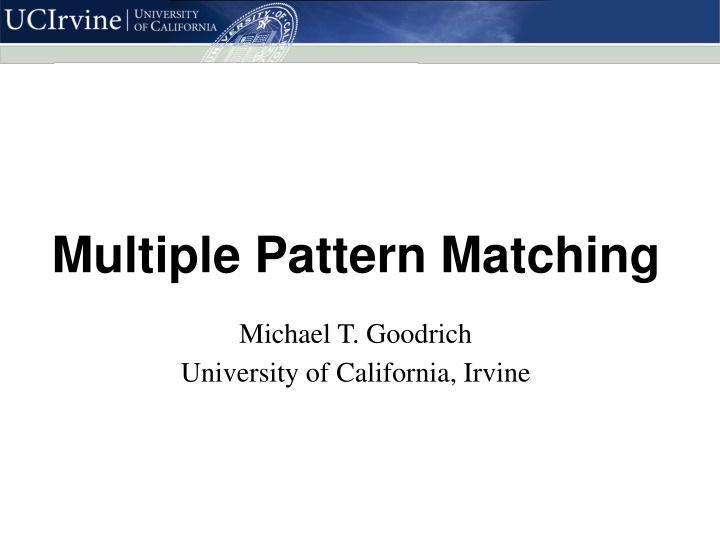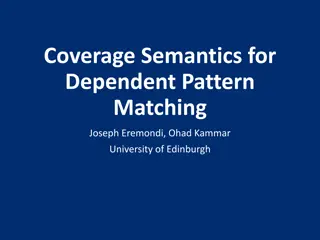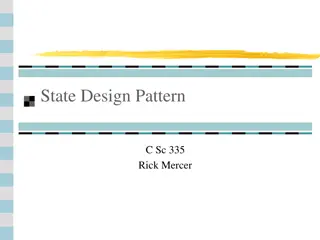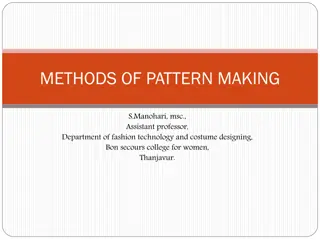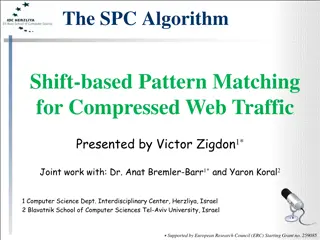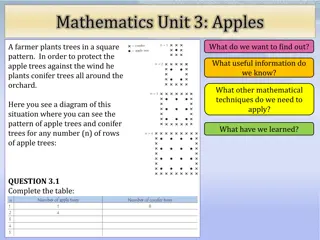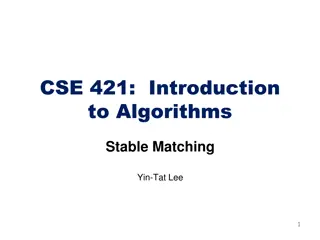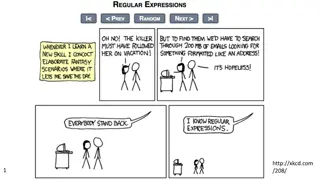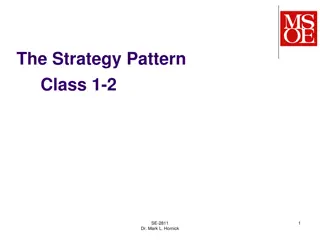Multiple Pattern Matching
Delve into the realm of multi-pattern matching algorithms such as brute-force, regular expression, KMP, and Rabin-Karp. Explore their efficiency, drawbacks, and applications in handling multiple patterns within a text sequence. Uncover the intricacies of hash tables and the Rabin-Karp algorithm for multiple patterns, shedding light on their role in enhancing pattern matching operations for complex datasets.
Download Presentation

Please find below an Image/Link to download the presentation.
The content on the website is provided AS IS for your information and personal use only. It may not be sold, licensed, or shared on other websites without obtaining consent from the author.If you encounter any issues during the download, it is possible that the publisher has removed the file from their server.
You are allowed to download the files provided on this website for personal or commercial use, subject to the condition that they are used lawfully. All files are the property of their respective owners.
The content on the website is provided AS IS for your information and personal use only. It may not be sold, licensed, or shared on other websites without obtaining consent from the author.
E N D
Presentation Transcript
Multiple Pattern Matching Michael T. Goodrich University of California, Irvine
The Multi-Pattern Matching Problem Given a text, T, of length n and a set of k patterns, P1, , Pk, each of length at most m, find the first (or each) occurrence of a given pattern in T. Image from https://www.sciencedirect.com/science/article/abs/pii/S0743731519301984
Multi-Pattern Brute-Force Algorithm We can run the brute-force algorithm k times. This would run in O(nmk) time, which is very bad. k Brute force algs. Image from https://www.sciencedirect.com/science/article/abs/pii/S0743731519301984
Alternative: Build a Reg. Exp. Given k patterns, P1, P2, , Pk, each of size at most m, build a regular expression: R = P1 | P2 | | Pk Then, use R to match for any pattern Pi. If we simulate the NFA for R, then this takes O(nmk) time. This is no better than brute-force!
KMP Algorithm for Multiple Patterns We can run the KMP algorithm k times. This would run in O((n+m)k) time, which is better than brute force but still not great. k diff. KMP algs. Image from https://www.sciencedirect.com/science/article/abs/pii/S0743731519301984
Recall the Rabin-Karp Algorithm The Rabin-Karp string searching algorithm calculates a hash value for the pattern, and for each m-character substring of text to be compared. If the hash values are unequal, the algorithm will calculate the hash value for next m-character sequence, using a rolling hash function If the hash values are equal, the algorithm will do a Brute Force comparison between the pattern and the m-character sequence at this location (in case of a hash value collision causing a false match). In this way, there is only one comparison per text subsequence, and Brute Force is only needed when hash values match.
Rabin-Karp for Multiple Patterns Text T = cbabacabb Pattern P1 = abaca, P2 = cabbb
Hash Tables The multi-pattern Rabin-Karp algorithm uses hashing in two ways: It uses the hash function, h, for computing the rolling hash values of the pattern and text substrings. It uses a hash table, H, for storing key-value pairs. This provides expected O(1) time insertions and lookups (see any good reference on hash tables for this) 1. 2. Image from https://www.tutorialspoint.com/data_structures_algorithms/hash_data_structure.htm
Rabin-Karp for Multiple Patterns Assumes a shiftHash function for computing a shifted hash value.
Analysis of the Rabin-Karp Multi- Pattern Matching Algorithm We are given a test of length n, and k patterns, each of length at most m. Use a hash function, h, that is random enough so the probability of a false match is at most 1/m. Use a hash table, H, that supports expected O(1) time insertions and lookups. Building H takes O(km) time, including computing h(Pi) for each pattern, Pi. Then the expected running time to find a first match for each pattern (if it exists) is O(n+km).
Tries e i mi nimize ze mize nimize ze nimize ze
Preprocessing Strings Preprocessing the set of patterns speeds up pattern matching queries If a document is large, immutable and searched for often (e.g., works by Shakespeare), we may want to preprocess the words in the document, each as a separate pattern A trie is a compact data structure for representing a set of strings, such as all the words in a document A tries supports pattern matching queries in time proportional to the pattern size
Standard Tries The standard trie for a set of strings S is an ordered tree such that: Each node but the root is labeled with a character The children of a node are alphabetically ordered The paths from the external nodes to the root yield the strings of S Example: standard trie for the set of strings S = { bear, bell, bid, bull, buy, sell, stock, stop } b s e i u e t a l d l y l o r l l l c p k
Analysis of Standard Tries A standard trie uses O(n) space and supports searches, insertions and deletions in time O(dm), where: n total size of all k of the strings in S m size of the string parameter of the operation d size of the alphabet b s e i u e t a l d l y l o r l l l c p k
Word Matching with a Trie insert the words of the text into trie Each leaf is associated w/ one particular word leaf stores indices where associated word begins ( see starts at index 0 & 24, leaf for see stores those indices) s e e 0 1 a 4 b e a r 6 7 ? s e l l s t o c k ! 2 3 5 8 9 10 11 12 13 14 15 16 17 18 19 20 21 22 23 s e e 24 25 26 27 28 29 30 31 32 33 34 35 36 37 38 39 40 41 42 43 44 45 46 a b u l l ? b u y s t o c k ! b 47 48 49 50 51 52 53 54 55 56 57 58 59 60 61 62 63 64 65 66 67 68 a r i d s t o c k ! b i d s t o c k ! h e 69 70 71 72 73 74 75 76 77 78 79 80 81 82 83 84 85 86 t h e b e l l ? s t o p ! 87 88 b h s e i u e e t y e a l l a l o d 36 0, 24 47, 58 r r p c l l l 6 69 84 78 30 12 k 17, 40, 51, 62
Analysis for Using a Trie for Multiple Patterns An example trie: potato poetry pottery school science A trie for k patterns can support a search for any one in O(m) time, but you have to start over a new search for each starting position in the text. Takes O(nm) time, which is the same as a brute- force search for just one pattern. Efficient for many patterns.
Suffix Tries (Trees) The suffix trie of a string X is the trie of all the suffixes of X The suffix trie for the string xabxac:
Analysis of Suffix Tries Building a suffix trie for a string X of size n Uses O(n) space Supports arbitrary pattern matching queries in X in O(m) time, where m is the size of the pattern Can be constructed in O(n) time (we will discuss how later)
Using a Suffix Trie for Multi-Pattern Matching Build a suffix trie for the text (not the patterns) Do a search for each of the k patterns. Total time: O(n + mk), assuming a linear-time algorithm for constructing a suffix trie (which we will discuss later in this class)
